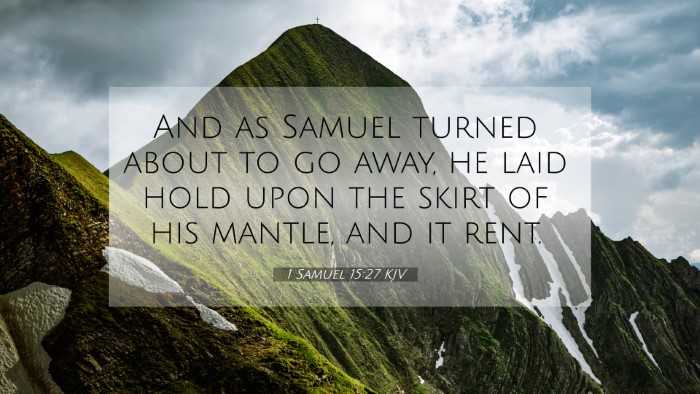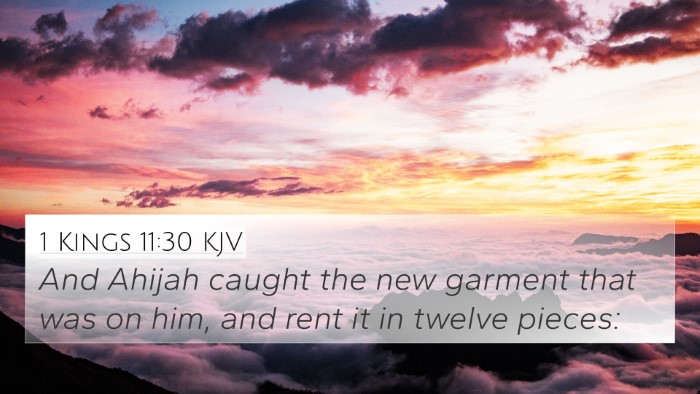Understanding 1 Samuel 15:27
Verse: "And as Samuel turned about to go away, he laid hold upon the skirt of his mantle, and it rent." (1 Samuel 15:27)
Summary of Meaning
The verse describes a pivotal moment in the relationship between the prophet Samuel and King Saul. This encounter highlights both the emotional weight of their parting and the serious consequences of Saul's disobedience to God's command.
Key Themes from Commentaries
- Broken Relationship: According to Matthew Henry, this incident signifies the rupture between Saul and God. Samuel's torn mantle represents the division caused by Saul's failure to follow divine instructions.
- Symbolism of the Mantle: Albert Barnes emphasizes the significance of the mantle as a symbol of Saul's kingship. The tearing signifies that the kingdom would be taken from him due to disobedience.
- Prophetic Authority: Adam Clarke notes that the act of tearing the mantle signifies the prophetic judgment against Saul, reinforcing Samuel's role as the intermediary between God and His people.
- Emotional Weight: The emotional turmoil experienced by Samuel is crucial. As a prophet, he had deep ties to Saul, and this moment signifies the painful decision of divine judgment.
- Divine Retribution: Commentaries consistently point out that this event reflects God’s justice. Saul's disobedience results in a tangible and significant consequence.
- Leadership Lessons: Many commentaries emphasize that Saul's failure serves as a warning about the importance of obedience to God's directives for leaders.
- Future Consequences: This verse sets the stage for future events in the narrative, including God’s choice of David as Saul’s successor, marking a significant shift in Israel's monarchy.
- Connection to Biblical Principles: The act of tearing can be seen as parallel to God’s desire for sincere obedience and the seriousness of covenant faithfulness.
Bible Cross-References
This verse connects thematically and contextually with several important scriptures:
- 1 Samuel 13:14 - The rejection of Saul as king for his disobedience.
- 1 Samuel 16:1 - God sends Samuel to anoint David, showing the transition of leadership.
- 1 Chronicles 10:13-14 - Highlights God's decision to reject Saul due to his unfaithfulness.
- Psalm 78:70-72 - This passage reflects God's choice of David over Saul, emphasizing David's heart for God.
- Luke 16:10 - Echoes the principle of faithfulness in small things, which is echoed in Saul’s larger disobedience.
- Romans 11:29 - The irrevocable nature of God’s gifts and calling, applicable to the leaders of Israel.
- Ezekiel 34:10 - God’srole as the shepherd who cares for His flock and judges unfaithful leaders.
Thematic Connections and Inter-Biblical Dialogue
This verse not only serves as a critical pivot in the narrative of Samuel and Saul but also opens up broader discussions on obedience in scriptural context. Following the event where Samuel tears his mantle, various biblical themes emerge:
- Obedience vs Sacrifice: Samuel's rebuke of Saul ultimately highlights a recurring biblical theme illustrated in 1 Samuel 15:22, where God prioritizes obedience over sacrifice.
- Repentance and Restoration: The narrative form a bridge to Jesus's teachings on repentance and forgiveness seen in Luke 15.
- Leadership Accountability: Echoed throughout the scriptures, including Titus 1:7-9, reflects the responsibilities of leaders in spiritual matters.
Tools for Bible Cross-Referencing
For those exploring the depth of scripture, understanding how verses relate to each other is critical. Consider the following:
- Bible Concordance: Essential for finding verses related to specific themes or words.
- Bible Cross-Reference Guide: A structured approach to understanding thematic links across the scriptures.
- Cross-Reference Bible Study: An invaluable method for delving deeper into the meanings and implications of scripture.
Using a comprehensive Bible cross-reference method allows for a rich study experience, enhancing the understanding of God’s word and its interconnectedness.



